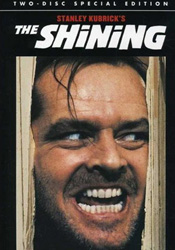
Day One – The Shining / Day Two – Full Metal Jacket / Day Three – Eyes Wide Shut
Day Four – A Clockwork Orange / Day Five – 2001: A Space Odyssey Mesage Board Discussion

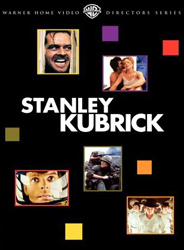 BUY IT AT AMAZON: CLICK HERE
BUY IT AT AMAZON: CLICK HERE
STUDIO: Warner Bros.
MSRP: $79.98
RATED: R
RUNNING TIME: 142 Minutes
SPECIAL FEATURES:
- Commentary by Garrett Brown and John Baxter
- Theatrical trailer
- Documentary The Making of the Shining, with optional commentary by Vivian Kubrick
- Three new featurettes: View from The Overlook: Crafting the Shining, The Visions of Stanley Kubrick, and Wendy Carlos, Composer
The Pitch
All work and no play makes a Stephen King adaptation much more than the author’s book dictated.
Director: Stanley Kubrick
Cast: Jack Nicholson, Shelley Duvall, Scatman Crothers, Philip Stone, Danny Lloyd, Barry Nelson, Joe Turkel
Writers: Stanley Kubrick, Diane Johnson
The Nutshell
This is arguably not only the most beloved and memorable [The Shawshank Redemption still has masses who don’t realize who wrote the source novella] Stephen King adaptation but also the one which strayed farthest from the source. No, The Lawnmower Man doesn’t count because who cares about that piece of shit. Kubrick’s use of Steadycam, relentless riding on Shelley Duvall through take after take, and Jack Nicholson’s mind-altering performance are only the tips of the iceberg. A divisive classic, The Shining enters the world of the triple-dip in widescreen special edition form.
The CHUD.com Staff Ruminates on The Shining:
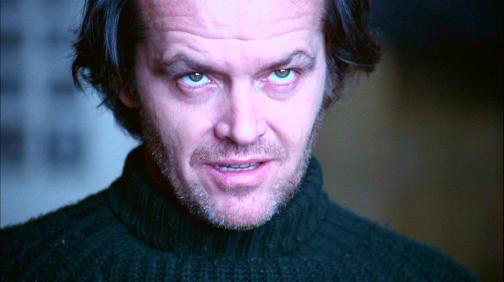
Whenever someone begins complaining
about a book adaptation being unfaithful to the source material, I point them
to the two versions of The Shining. Stanley Kubrick’s bastardized take on
Stephen King’s novel is a classic while Mick Garris’ exceptionally accurate TV
miniseries is almost unwatchably bad. I can understand some of King’s problems
with Kubrick’s film, especially the fact that Jack Nicholson comes across as a
crazy man before he’s even set foot in the Overlook Hotel, but in the end it
all feels like sour grapes to me. What bugs King most is that Kubrick didn’t
just make The Shining his own, he made it better.
During the production of The Shining, King claims he got a call from Kubrick
where the director asked if ghost stories weren’t just a reaffirmation of the
afterlife. King said he didn’t think so, an Kubrick responded by asking if the
author believed in God. When King said he did, Kubrick replied, ‘No, I don’t
think there’s a God,’ and hung up the phone. It’s that tension between the
author and the auteur that gives The Shining its edge; Kubrick approaches the
material from a totally askew perspective, leading him to make one of the most
unique ghost stories of all time. It’s that perspective that allows the film to
have that mindfuck finale, where Jack Torrance is in a photo from the
Overlook’s heyday, decades before he was ever even born.
While I do come down squarely on the side of Kubrick’s film as a bigger
artistic achievement than the book, I can’t criticize someone who finds that
the book works better for them. Taste is subjective, even if true quality
isn’t. But even for the people who like the book better, there’s still the book.
No adaptation has ever caused the recall or destruction of the source material,
meaning that the original that is so beloved remains available. In the case of
a movie like The Shining you get not only the ability to read the original
material, you get to enjoy another mind’s take on that material. I don’t go to
a film adaptation looking for a complete replay of the book in cinematic form.
Instead I’m looking for a dialogue between author and adapter, one where themes
and concepts are riffed on and examined from whole new angles. That’s exciting,
the ability to approach a story from as many perspectives as possible.
People hoping to see the book’s original ending filmed were disappointed for
years, until Mick Garris’ miniseries stepped up to the plate and really
disappointed them. The Shining miniseries debacle proves that fidelity isn’t a
guarantee of quality.
– Devin Faraci
The Shining’s a prime example of how to make a great movie out from a shitty book. I like Stephen King, but I don’t find The Shining
to be one of his best. It’s melodramatic to a fault, clichéd, and it’s
got all the subtlety of a flying mallet. Plus, it inspired that
god-awful Stephen Weber/Melvin Van Peebles TV version. People should
die for making that one. And Kubrick, spurned on by his desire to make
a horror film that would outdo those of his peers, wisely chose to
throw out almost everything in the book for his film version. The names
remain the same, but the story… ah, there’s the rub.
Here’s the thing: King’s story will fade. It’s too literal, too geared
for thrills. Kubrick’s thrives on ambiguity. It’s entirely possible
that none of the ghosts in the Overlook Hotel are real. That it’s all a
product of the alcoholism and abuse that thrives in the Torrence
family, what Roger Ebert hints at in his “Great Movies” review of the
film as a kind of shared delusion. And that uncertainty gives the flick
power. It gets under your skin, so even if you initially see it and
find it less than viscerally satisfying as a horror movie the first
time (as I did), the fact that the horror isn’t resolved or unexplained
stays with you. You keep coming back to it, and I grow more unnerved by
the flick the more times I see it. Along with John Carpenter’s The Thing, The Shining is the best horror movie of all time.
Look
at 2001: A Space Odyssey
and you’ll never mistake it for anything other than a technologically advanced
film. But The Shining, which looks like a natural horror flick made with
amazing talent but minimal technology, is also an example of cutting-edge
filmmaking. That fact’s rather hidden nature makes the film valuable and
compelling even for the Stephen King fan angry at Kubrick’s swath of story
alterations.
The
Steadicam, now the most prominent part of any camera accessory package, was a
new piece of kit in 1980. It had been used for a few years, but mostly as a way
to smooth handheld shots. Until Stanley Kubrick and John Alcott got hold of it,
no one had truly innovated with the Steadicam, and in the years since The
Shining, few people have worked with it as elegantly.
History
lesson: Before Garret Brown (present on the new disc’s commentary track) came
up with his ingenious stabilizer, camera movement was limited to shaky handheld
shots and dolly setups where track was an inescapable reality. The Steadicam
opened up a world of camera movement unencumbered by dollies, and a field of
vision unmarred by track, where an operator could take the camera anywhere he
could walk.
The
skill required to successfully manipulate a Steadicam is enormous and requires
the sort of teamwork that makes film such a unique medium. The focus puller has
to keep the shot in focus by remote, constantly estimating the distance from
lens to subject to make the shot work. A good operator and assistant team
(typically with a rock steady grip around to make sure footing is secure) is an
amazing thing to watch.
Alcott’s
deep-focus photography made focus puller Maurice Arnold’s job easier, but
placed serious extra burden on everyone else, and the craft on display in The
Shining, from sets to lighting to effects, thrills me every time I see
it.
– Russ Fischer
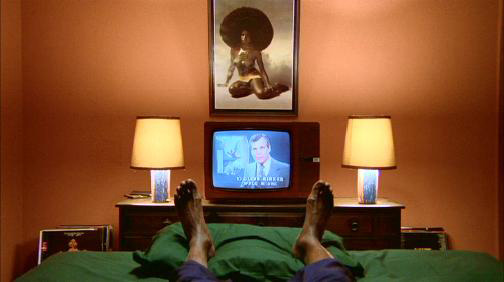
I’ve gone through more emotions with this film than few others in my life but one thing has always remained constant, my love for it. It’s amazing how I can watch it three different times and have it be three different movies for me. It can be a very cold and measured chiller for me, allowing its pace and distance and moments of amazingly effective horror affect me as the author intended. It can be a character study that I pore over for the artistry present in every of the 24 photographs per second Stanley Kubrick is gracious enough to share with me. It can be a nearly side-splitting comedy as Jack Nicholson goes from mildly saucy to downright hilarious in his extremely quotable role and though I probably am wrong for turning the film off before he loses, I can’t help it. When seeing this film as anything but a horror film it’s a far different experience. Scatman Crothers is a killjoy, little Danny Torrance is a nuisance, and Wendy Torrance deserves whatever edged weapon comes her way. The spooky patrons of the Overlook Hotel are a lot more fun than Jack Torrance’s support staff, keeping him from having any damn fun whether it be a little booze, a little nookie, or a clear head to write with. it’s not the intended way to watch The Shining but Stanley Kubrick’s film are singular in the way they transcend their concepts. 2001: A Space Odyssey became a counterculture trip, Barry Lyndon became a film school master class in the use of lighting and modification of the motion picture camera, A Clockwork Orange became an instructional video, and Eyes Wide Shut became a wholly unintended piece of erotica for the repressed. So, while this film maybe doesn’t deliver the scariest horror film… maybe it does. There’s a reason only a select few films in the genre transcend time, and this is certainly one mentioned in the same breath as The Exorcist or Psycho. It’s a sneaky little film and to watch it alone in the dark without any previous knowledge of the source must be a terrifying experience. Rarely has isolation been so elegantly portrayed on film. Regardless of what it means to the individual viewer, this is a film with serious legs. One of the most important and beloved films of my lifetime, that’s for damn sure.
– Nick Nunziata
Don’t get me wrong, I like The Shining a lot. But I never really found it all that scary. I’m sure a lot of that has to do with the fact that The Shining has been spoofed and referenced so many times in other media that I
felt like I’d seen it already. As soon as that axe started coming
through the door, I know what line was coming. As soon as little Danny
started talking about red rum, I knew exactly what it meant. And as
soon as they went into that hedge maze in the dead of winter, I knew
exactly how it would end.
The Shining is a movie that has had
such an effect on our cultural lexicon that it’s virtually impossible
to go into it completely fresh. I blame The Simpsons, mostly.
But The Shining has so many fantastic moments that I can’t
help but look past its absence of scares, from the long tracking shot
following Danny’s big wheel, to the shot looking down at the model
hedge maze revealing two tiny figures roaming around below, to Wendy
warding Jack off with the baseball bat, and finally the iconic moment
when axe meets door… There’s no doubt that Kubrick was at the top of
his game here. It’s almost too bad that The Shining has become
such a cultural touchstone, since I have a sneaking suspicion I
would’ve found it a lot scarier if I didn’t essentially know the entire
plot of the film going into it. I admire the movie more than I
genuinely enjoy it.
In spite of that, what makes The Shining so watchable for me is
for Jack Nicholson’s performance, which is gleefully (and justifiably)
over the top. People like to complain about his characterization of
Jack Torrance, saying that instead of making him a regular guy that
goes off the deep end, Nicholson plays the character as being nuts
right from the word go. And sure, it’s true that Nicholson’s character
does seem a little deranged at the start of the film. But that doesn’t
mean the character doesn’t have an arc. Going from slightly crazy to
bat-shit insane is still character development, no matter how you slice
it.
While The Shining isn’t my favorite Kubrick film, but it’s
also the one I brought the most baggage to, so it’s hard to say whether
I would’ve had the same reaction if I had seen it during its initial
release. Probably so.
Goddamn Simpsons.
While many people point to 2001: A Space Odyssey as Stanley Kubrick’s masterpiece, I believe you can learn just about anything you need to know about filmmaking from watching The Shining.
The movie to me is a master course in how to frame a movie and it is an
inspiration to me as a filmmaker and a wonder to me as a movie fan.
I had read the Stephen King novel before ever watching the movie. As a
King fan, I was very excited about the movie based on the novel and
could not wait to see it brought to life on the screen. My original
feelings were that the movie was disappointing to me as a fan of the
original novel. In the adaptation, Kubrick decided to eliminate the
true evil of the novel – The Overlook Hotel – and instead concentrated
on the isolation that drove an already unstable Jack Torrance to an
unspeakable rage. This bothered King also, who stated in his novel
Danse Macabre: “… the book is about Jack Torrance’s gradual descent in
madness through the malign influence of the Overlook … If the guy is
nuts to begin with, then the entire tragedy or his downfall is wasted.
For that reason, the film has no center and no heart.”
While that is all very good and well, the movie itself has grown to be
just as important, maybe even more so than the original work on which
it was based. Kubrick made a career out of adapting novels into movies,
many times taking on books that seemed to be un-adaptable. What Kubrick
would do is take the central idea of the book and then take it in a
direction that would make it his own. The way he would accomplish that
in The Shining was to take the central idea of a family
isolated in the hotel in the dead of winter, alone and with very little
chance to encounter anyone else, and show their descent into terror.
Kubrick began the movie with a large, wide aerial shot of the family
driving through the mountains to the hotel itself. When the hotel is
finally introduced, it is through another wide shot, showing it as the
open aired vacation site it was. As Jack moves through the hotel to
interview for the job, we get a long tracking shot that follows him and
introduces the hotel, once again as a wide open, inviting destination.
This is Kubrick’s way of setting up the hotel for the later scenes,
where the framing of the shots grows tighter and tighter until finally
at the end, we get Jack in a small cavern, facing his demise. Kubrick
uses the framing of the shots to creating a suffocating, claustrophobic
effect for the viewers, to parallel the pressures facing the Torrance
family as the winter moved on.
Another item Kubrick uses throughout the movie is his placement of
lights. At the times when Jack is conversing with the dead, the
lighting is set up meticulously to backlight the dead. Whether it is
the bartender behind the bar or the butler in the bathroom, the lights
are set up naturally to allow white backlight to almost create a halo
around the ghosts as they pass on information to Jack. It is another
touch that is used by Kubrick to subtly pass on small pieces of
information through the composition of the mise-en-scene, a skill he
had perfected by this time.
While the story does not really hold true to the feelings of the book,
it is still a masterpiece in its own right. When looking back on the
two, the King story remains the more well rounded, easy to follow
story, but the Kubrick film rises above. It is a case where the written
material may have more meat to it but the adapted film has much more
artistic value and more depth, making it a much more quality work of
art. The story of isolation and the madness it incurs is told
masterfully through the direction of a master of his profession and The Shining holds up today as one of the greatest horror movies to ever hit the silver screen.
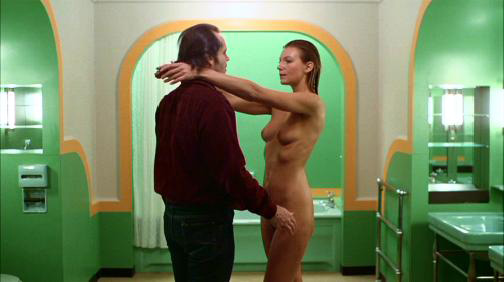
"It was like malevolent POV. Evil was following the kid, evil was
following the kid."
That’s Cinema Products Corporation’s Ed
Di Giulio raving to Stanley Kubrick in response to the director’s iconic use of
the company’s then newfangled steadicam in The Shining, and that
"malevolent POV" has caused more sleepless nights than I care to
remember. Just as Kubrick was enriching
the language of film with his prolonged takes of Danny prowling the deserted
halls of the Overlook Hotel, he was also altering the language of my
nightmares. And while Kubrick wasn’t the
first to keep me up nights using this particular piece of equipment (John
Carpenter’s Halloween had already slashed its way into my subconscious), the
unrelentingly predatory sense conveyed by camera operator Garrett Brown as he
did nothing more than trail a kid on a big wheel was indelible; I’m well into
my thirties, and these scenes still won’t leave me alone.
The atmosphere of The Shining is far
creepier than its narrative content, which is more of a riff on Stephen King’s
novel than a straight-up adaptation. And
while King purists love to rail against the movie, it chases after the
ineffable in ways that would probably befuddle the steadfastly linear
"Master of Horror". I didn’t
know what "sexual dread" was when I first saw The Shining, but I sure
felt it when Nicholson embraced that gorgeous nude woman only to end up with
two armfuls of decrepit hag. And the
sight of Hong Kong Phooey catching an axe in the tummy didn’t exactly feel
right.
I’ve never been able to settle my
thoughts on The Shining because the movie so unsettled me as a youth. I’m very sure it’s not a great movie, and
there’s no doubt that it’s one of Kubrick’s weakest efforts. But there really is a probing malevolence to
the piece. It keeps after you. And that’s almost enough.
– Jeremy Smith
The Shining opens with some of the oldest, most
recognizable church music ever written: Dies Irae ( Latin: “Day of
Wrath”). It’s a chant that was written in the thirteenth century for
the catholic requiem mass, and it sets the tone of Kubrick’s film
perfectly. It’s one of the few films that feels as cold and dark as an
American funeral, and it’s one of the few King adaptations to rise far
above its source material.
For me, my favorite part of The Shining
is the final shot, which shows Nicholson’s Jack Torrance frozen in time
in 1921 as crowd chatter bubbles from the background. What’s great is
that when this scene played to theaters in 1980, I’d wager that not too
many people noticed the crowd chatter- it probably blended in nicely
with the after-movie conversations we all have as the theater lights
come back on. The way the sounds of the Overlook hotel staff mingled
with moviegoers’ voices implies a ghostly cinematic wake for Jack
Torrence, and a sort of secret, almost sinister communion between the
viewers and the film. “You’ve always been the caretakers here.”
There’s been much talk about The Shining’s
alleged Native American symbolism (Google “The Shining” and “Bill
Blakemore” if you’re interested in reading about it). I’m not going to
dispute or confirm that, although I lean toward it being mostly wishful
thinking. Either way, The Shining, like most of
Kubrick’s other works, transcends its genre. It’s not a slasher film,
since there’s only one axe-related death in the whole movie, and with
the exception of a freezer door mysteriously unlocking itself, the
Overlook’s ghosts might have been entirely imaginary. It’s a
wonderfully chilly film that ranks amongst my favorites, and is one of
Kubrick’s most entertaining and re-watchable films.
Seeing this in theaters with friends was a memorable moment mainly
because of all the screaming we did. The things that caused me to
scream back then is not the same scenes that give me chills today. Back
then it was the blood slowly flowing out of the elevator, the evil
looking twins, the beautiful woman who transforms into a walking
corpse, all those were moments I’ll never forget.
Today when watching this movie there are other parts that scare me. The
way Kubrick gradually introduces the viewer to Jack’s insanity. What is
so great about this is Kubrick does not do this critical part of the
story quickly and only offers hints here and there until the third act
when we see Jack in his full nut job glory. Horror directors today
could learn a thing or two from Kubrick and after it’s all said and
done, The Shining is one of the greatest psychological thrillers of all
time.
I
know I’m probably going to be the lone voice of dissent here. While I
find The Shining to be a very good film, it’s hardly the masterpiece
most claim it to be. Stephen King actually got it right- this film just
has no heart.
It’s true. There’s not much emotion at all in the
film, in fact. Even at the end when everyone’s running and screaming in
fear it rings as hollow, simply because you don’t really have any sort
of grasp of these people’s relationships, or even care about them. By
changing the plot of the book and focusing it on a family that’s about
to crack, there’s no suspense. None. You know what’s going to happen
from the very beginning when the Hotel employee tells Jack about the
caretaker who chopped his family up into bits. The rest is just waiting
for it to happen.
While I’m not the biggest fan of the film
narratively speaking, visually is another story. You can’t help but
admire how Kubrick framed it, his newfound love of the steadicam, and
man oh man, how he used that hotel. In almost every shot the characters
are tiny against the wide-open, empty expanse of it. It really is as
substantial a character as any of the family members, creating a lonely
yet claustrophobic mood. That’s only compounded by the title cards,
which force you to realize that time’s slowing down almost to a
standstill, as the duration between them gets shorter and shorter (from
months to hours).
As a horror film though it fails for one simple reason- it’s just not scary.
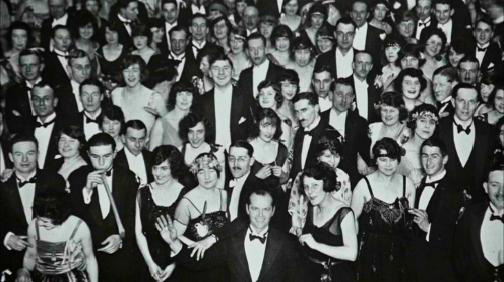
It’s hard to believe this movie was ever sold as anything but
‘Nicholson goes nuts with an axe’, or that anyone watching it for the
first time thought for a freaking second
that Jack would really find (or was even looking for) some peeeeace and
quiiiiiet at the Overlook Hotel. And yet, the story’s supposed to hinge
on the shock of Dad Going Bad. Had Kubrick seen too many horror flicks,
or not enough? The first three times I watched this movie I fell asleep
after the first round through the hedge maze, only reviving to find
myself staring straight up Scatman’s nostrils. If there’s any
consistent element throughout Kubrick’s work, it’s those two closeups:
the high angle, jaw slack, eyes rolled up through the brows; and the
low angle, Everything You Wanted To Know About Nose But Were Afraid To
Ask. I’m pretty sure every one of his films employed some luckless
crewmember on full-time Booger Detail.
Shelley Duvall isn’t that bad in The Shining. She annoys the hell out
of me, but it works. You get the feeling that, even without ghosts
being involved, Jack would have gone crazy at some point during the
winter. And how satisfying would it have been if he had killed her?
Chainsaw-meets-Franklin satisfying. It’d also be a prime example of
justifiable homicide.
A ghost exists in the reflections of the demons that we can’t stare in
the face. I’ve been talking about this film a lot recently. When I was
talking to a British fan, he brought up the fact that he didn’t notice
a major detail until viewing the recently release Kubrick set from
Warner Brothers. At first, Jack Torrance can bring himself to deal with
the stress of a family that is growing away from him. He’s no longer
the stable provider that can support a family.
Taking care of the Overlook Hotel is a last ditch job, while he tries
to pull it all together and write that novel that’s going to save his
life. But, the novel is going nowhere and he’s fighting with his wife
over what to do with their freaky kid. That’s where we find the real
beauty in the piece as Jack finds Lloyd and Grady. At first, he can’t
bare to look at them. But, he’s more than willing to follow their
commands. As soon as he can accept the horrors of Room 237 and love the
demons that dwell within his fractured soul, Jack comes to realize a
universal truth. He has always been at the Overlook. It’s just his
miserable life has been the purgatory awaiting the chance to return to
the icy pits of Hell.
The Shining was the first Stanley Kubrick movie I saw. I used to wait
up in my room until my parents went to bed, then sneak downstairs and
check out channel five for the Saturday Night Late Movie. I’ll never
forget the times I turned it on in the middle of Altered States or the
clown scene from Poltergeist. I had quite a few nightmares thanks to
the channel five Saturday Night Late Movie, but none were as severe as
the dead girls from The Shining, staring down into my soul ready to rip
it right out of my heart and eat it in front of my useless, dying
vessel. Imagine turning on the television and seeing a child rolling
down a hallway on his big-wheels, only to round the corner to confront
two creepy twins. Then, a flash of the same twins axed into bloody
quintuplets on the floor. I remember I recoiled from the television. I
didn’t want to touch it, not even to turn it off. So, I didn’t. I
stayed up the rest of the night and watched it to the terrifying last
shot of Jack, frozen forever inside a photograph, and I shivered my way
through the credits. I didn’t understand what that could possibly mean
at the time, but it sent my mind reeling in spirals of fear that
culminated in some of the worst nightmares I’ve ever had in my life.
There are few things more unifying in all horror movies as “the creepy
twins from The Shining.” Everyone has their own story about
encountering them for the first time, but I’ve never met anyone who
said they didn’t find them scary that I truly believe. The Shining is a
truly odd, frightening film. It has a wildly strange performance from
Jack Nicholson, who acts like Captain Alcoholic from the first frame.
It has a dead woman in a bathtub. It has an elevator full of red
Kool-Aid blood (“Oh, yeah!”). It has the hedge maze from hell, a kid
talking to his finger and a guy giving a blow job in a bear suit. But
nothing beats those twins, looking straight into my eyes and whispering
in a faint English accent, “Come and play with us, Danny.” It’s their
polite invitation that does it, and their odd synchronized departure
that still haunts my dreams. I look for them in long hallways
sometimes. And I shudder at the possibility of meeting them, even if
it’s just for a few minutes in a very bad dream.
The Package
The commentary track by film historian John Baxter and Steadycam inventor Garrett Brown is informative and sometimes quite an entertaining listen but at times the two men bleed together and it’s hard to remember which is which. Also, while their contributions to the DVD are helpful, the absence of any of the major players hurts the overall impact. There’s not enough of the Kubrick mystique on the track, leaving it a bit dry and little more than a fun curiosity. That said, it ties the bond between this film and the Steadycam even tighter and there’s value in that.
Vivian Kubrick’s documentary is an interesting thing to watch because of how unorthodox it is and because it shares some rare moments of Kubrick actually at work with his actors and crew and there’s some really great stuff in there, especially a moment where Kubrick comes up with this amazing and memorable shot:
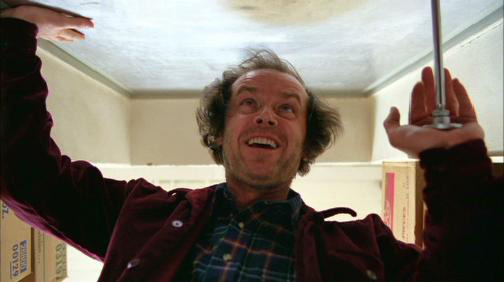
I think it only makes the director seem that much more enigmatic and brilliant, seeing him in these disassociated little moments, typing away oblivious to his surrounding chatter, giving Duvall what-for after she missed an "action" call, walking around in his own world while Nicholson prepares for a scene, and more. It doesn’t have the narrative focus of most documentaries but it’s a nice compliment to the film.
Of the three new featurettes for this release, the best by far is the View from the Overlook bit, but all of them do a nice job of rounding out the package and for the first time it feels like the folks behind the scenes delivered a DVD deserving of this film and its creator.
9.4 out of 10
